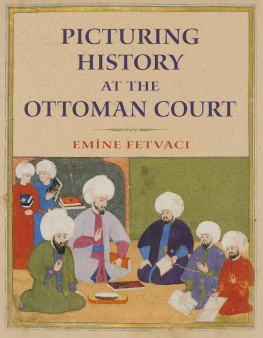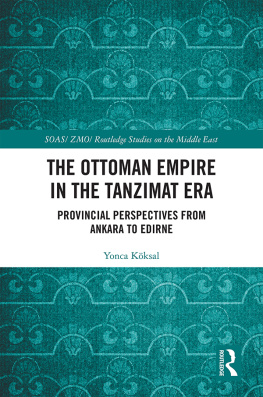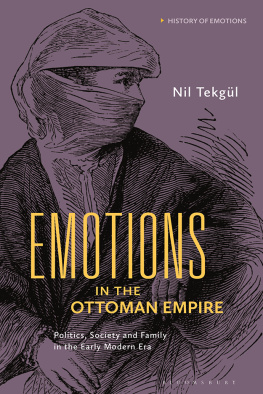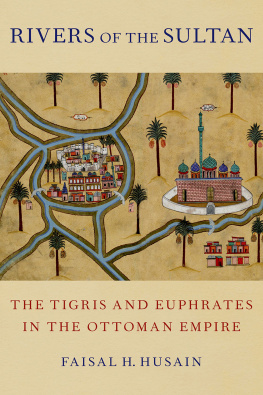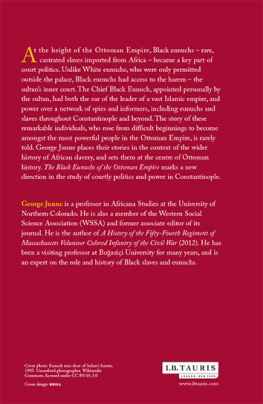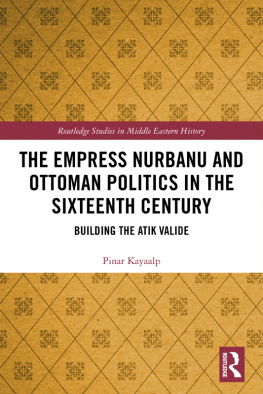
Picturing History at the Ottoman Court
Picturing History at the Ottoman Court
EMNE FETVACI
INDIANA UNIVERSITY PRESSBloomington & Indianapolis
This book is a publication of
INDIANA UNIVERSITY PRESS
601 North Morton Street
Bloomington, Indiana 47404-3797 USA
iupress.indiana.edu
Telephone orders800-842-6796
Fax orders812-855-7931
2013 by Emine Fetvac
All rights reserved
No part of this book may be reproduced or utilized in any form or by any means, electronic or mechanical, including photocopying and recording, or by any information storage and retrieval system, without permission in writing from the publisher. The Association of American University Presses Resolution on Permissions constitutes the only exception to this prohibition.
This book is printed on acid-free paper.
Manufactured in China
Library of Congress
Cataloging-in-Publication Data
Fetvac, Emine.
Picturing history at the Ottoman court / Emine Fetvac.
pages cm
Includes bibliographical references and index.
ISBN 978-0-253-00678-3 (cloth : alk. paper) 1. History in art. 2. Illumination of books and manuscripts, Ottoman. I. Title.
ND3343.8.F48 2013
745.6'709561dc23
2012025512
1 2 3 4 5 18 17 16 15 14 13
FOR CANDAN, ORHAN, AND ZEYNEP FETVAC
Contents
Acknowledgments
I am delighted to have this opportunity to thank the colleagues and friends who provided much help as I worked on this project. Glru Necipolu and David Roxburgh have been firm supporters and generous mentors, and their exemplary scholarship continues to inspire my work. This book simply would not have been possible without their encouragement, advice, and friendship. They also provided invaluable feedback on earlier drafts of the book. I am grateful to Cemal Kafadar, Irene Winter, Wheeler Thacktson, and the late inasi Tekin for their support. Filiz aman, Zeren Tannd, and Cornell Fleischer have been extremely generous with their ideas and time. Two particular conversations with Cornell Fleischer in February 2004 and March 2009 were integral to the development of some of the ideas in this book.
I am greatly indebted to the following institutions, curators, and library and museum directors who granted me access to the materials in their care: Mary McWilliams, Harvard University Art Museums, Cambridge; Dr. Elaine Wright, Chester Beatty Library, Dublin; the Directorate of the Beyazt Library, Istanbul; Dr. Meral Alpay, Yasemen Akay, and Zekiye Eraslan, Istanbul University Library, Istanbul; the Directorate of the Kprl Library, Istanbul; Durmu Kandra, Prime Ministry Archives, Istanbul; the Directorate of the Sleymaniye Mosque Library, Istanbul; lk Altnda and Sevgi Aca, Topkap Palace Museum Archives, Istanbul; Muhammad Isa Waley, British Library, London; Sheila Canby (now at the Metropolitan Museum of Art, New York) and Ladan Akbarnia, British Museum, London; Linda Komaroff, Los Angeles County Museum of Art, Los Angeles; Sylvie Merian, The Pierpont Morgan Library, New York; Annie Berthier, Monique Cohen and Francis Richard, Bibliothque Nationale, Paris; M. Nicolas Sainte-Fare Garnot, Muse Jacquemart-Andr, Paris; and Dr. Ernst Gamillscheg, sterreichische Nationalbibliothek, Vienna. Two museums deserve special mention: at the Museum of Turkish and Islamic Art, Istanbul, I was warmly welcomed by the former director Dr. Nazan ler, Dr. ule Aksoy, and Sevgi Kutluay, who also kindly assisted me with the photographs. At the Topkap Palace Museum in Istanbul, I owe a debt of gratitude to Dr. Filiz aman, former Director, and would like to thank Prof. lber Ortayl, Director, Glendam Nakipolu, Deputy Director, and Esra Myesserolu. I owe special thanks to Zeynep elik Atba of the Topkap Palace Library, for her friendship and help through the years. Zeynep and the rest of the Topkap staff went out of their way to help with permissions, images, and of course with viewing the manuscripts under their care. My dear friend and photographer extraordinaire Hadiye Cangke produced the photographs that enrich this volume and bring life and color to its pages.
I am grateful to Shahab Ahmed, Diliana Angelova, Gina Cogan, Sinem Erylmaz, Zeynep Yrekli Grkay, Eugenio Menegon, Asl Niyaziolu, Ceylan Orhun, Sunil Sharma, Daniel Star, Baki Tezcan, Alicia Walker, and Gregory Williams, who kindly read significant parts of the text at different stages and provided invaluable advice. Andrs Riedlmayer has been a constant source of wisdom over the years, and, along with Himmet Takmr and Ycel Demirel, has also helped with the difficult Ottoman passages. I presented earlier versions of some chapters at the Abbasi Program in Islamic Studies at Stanford University; CAA Annual Conference; the Aga Khan Program for Islamic Art and Architecture Lecture Series at Harvard University; and the University of Washington Department of Near Eastern Languages and Civilizations, all in 2006; the Networks of Exchange in the Mediterranean symposium at the University of Toronto Scarborough, and the Boston University Graduate Student Art History Association Lecture Series, both in 2007; and at the HIAA Symposium in 2008. My heartfelt thanks go to the participants and audiences at these events and especially to Robert Gregg, Aaron Rodrigue, Shreve Simpson, Glru Necipolu, Selim Kuru, Nathalie Rothman, and Barry Flood, chairpersons and organizers, for their helpful comments and criticisms. My participation in the Folger Library Faculty Seminar Constantinople/Istanbul in 2007, organized by Palmira Brummett, enhanced my thinking on some of the issues covered in this book. I also benefited greatly from conversations with the following friends and colleagues: Walter Andrews, Serpil Bac, Persis Berlekamp, Palmira Brummett, Giancarlo Casale, Zeynep elik Atba, Erdem pa, Tln Deirmenci, Holly Edwards, Stine Grodal, Christiane Gruber, Robert Harrison, Mehmet Kalpakl, Hakan Karateke, Elizabeth Kessler, Tijana Krsti, Selim Kuru, Ersu Pekin, Bissera Pentcheva, Florian Schwarz, Matthew Smith, Ebru Turan, the late Stefan Yerasimos, Ayin Yoltar Yldrm, and Michael Zell. Yasmine Al-Saleh, Sahar Bazzaz, Jennifer Pruitt, Dana Sajdi, Ilham Khuri-Makdisi, Asl Niyaziolu, and Sibel Zandi-Sayek were my companions as I wrote and revised the book at Widener Library over the past four years, and I thank them from the bottom of my heart for their warm friendship. Kristina Van Dykes friendship, emotional support, and intellectual complicity have been integral to the research and writing of this book. Eser and Memduh Hacolu, Berin Hikmet and my sister Zeynep Fetvac have graciously hosted me in their homes in Paris and London during research trips.
Research for this project was conducted with the assistance of the Aga Khan Program for Islamic Art and Architecture at Harvard University; the C. E. Norton Fellowship for Dissertation Research; the Whiting Dissertation Completion Grant; the Joukowsky Family Foundation Grant of the American Research Institute in Turkey; and the Stanford University Humanities Fellows Program. I wrote the book during two semesters of leave from Boston University, made possible by the Peter T. Paul Career Development Professorship. I am grateful to Peter Paul for his generous support which has also funded many research trips, and to my colleagues in the History of Art and Architecture Department for their encouragement during the writing process. Funds from the Peter T. Paul Professorship, supplemented by a Publication Production Grant from the Boston University Humanities Foundation, made it possible for this volume to be published with more than one hundred color images. I thank the anonymous readers from Indiana University Press for their very helpful criticisms. At Indiana University Press, I would like to thank Robert Sloan, Sarah Wyatt Swanson, June Silay, and Hila Ratzabi for supporting the book and overseeing its production with care.
Next page
